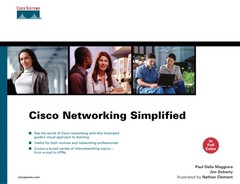The Internet uses Internet Protocol (IP) as its exclusive Layer 3 network protocol. Corporate networks, however, have run many other protocols over the past 20 years and find themselves wanting to migrate to an IP-only network. IP has become the de-facto network protocol for nearly every data-based application.
However, other network protocols still in existence are Layer 3 routed protocols such as the NetWare Internetwork Packet Exchange (IPX) and AppleTalk and layer-bridged protocols such as Systems Network Architecture (SNA) and NetBIOS. Today’s routers and switches allow these other protocols and IP to coexist on the same physical network.
Managing multiple networks adds complexity and extra cost. Companies are working to converge as much network traffic as they can into single-protocol IP networks. The advantages to a converged network include the following:
Reduced equipment costs and design complexity
Reduced training
More predictable traffic patterns and response times
Singular quality of service (QoS) and availability strategy
The primary mechanism for converging traffic onto a common IP network involves tunneling. Simply put, IP tunneling is the process of putting one type of packet into an IP packet. The packet traverses the IP network to the IP destination, in which the receiving device extracts the original packet from the IP packet and then passes it onto the destination device on its native network.
Cisco is a prominent player in multiple non-IP network markets primarily because of its ability to tunnel. Examples of technologies that can tunnel through IP networks include the following:
SNA (Systems Network Architecture)—. Developed by IBM for IBM mainframes
Telephony—. Traditional voice traffic between phones
Storage—. Protocols that allow servers to communicate with disk drives over a network
Because these technologies tunnel through IP networks, they benefit from IP services such as QoS and availability functions such as Hot Standby Router Protocol (HSRP). As a result, you can apply a single comprehensive strategy for prioritizing important traffic and handling network outages across application types.
The singular approach also presents problems that network designers must address. Certain SNA protocols require quick and consistent response time. As a result, network congestion that prevents tunneled SNA traffic from achieving expected response times can result in loss of connectivity to a mainframe.
The same applies to tunneling telephony. Network congestion can detrimentally affect the quality of one or more calls. The caller whose call meets congestion will experience strange choppy conversations or notice his call drop altogether. For companies consolidating their telephony and IP networks, a lack of quality can prohibit a successful rollout.
As a result, you must give special consideration when migrating one network technology, such as SNA or telephony, onto another such as IP. You must design the network in such a way that the network devices have enough bandwidth and processing power to deliver time-sensitive traffic while throttling back less sensitive traffic.
You can also use tunneling for security purposes. For example, corporations might want their employees to access the corporate network from the Internet. Although firewalls and other systems can protect the internal networks, corporate traffic traversing a public network can still be a problem. With readily available tools, hackers can intercept and perhaps alter the traffic as it travels between the Internet-based employee and the corporate network.
Through the use of protocols such as Internet Protocol Security (IPSec), the corporation can encrypt (scramble) the traffic such that it cannot be recognized unless the user knows certain keys. IPSec essentially tunnels the corporate traffic in the following way: Before traffic hits the Internet, a device (such as a router or PC) encrypts the contents of the traffic.
Generic routing encapsulation (GRE) is a type of tunneling that lets you tunnel any type of traffic. GRE is often used to tunnel unroutable protocols through an IP network.
Aside from tunneling, application and file server vendors are migrating their traditionally proprietary protocols to IP. For example, Novell NetWare and AppleTalk operate natively over IP.

